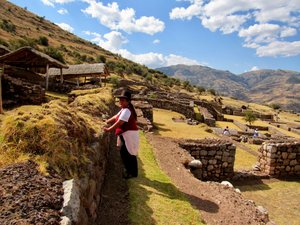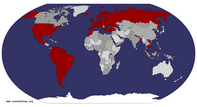Advertisement
Published: September 20th 2019

 The Guide
The Guide
Sabina grew up in the nearby town of Yaurisque and was hired as cook and guide by the group who took us in. Her personal stories of visiting the sites as an 11 year old and recounting of the legends of the beginning of the Incan Empire mixed together to make our experience visiting the site truly magical.Mauk'allaqta, also spelled several different ways, is a very well preserved and also recently uncovered and restored area. Only in the past 20 years have archeologists been uncovering the ruins and restoring some of the buildings. Nearby is another archeological site named Puma O’qro. This is a limestone cliff that houses the cave from which the legendary Ayar brothers emerged.
For a day trip to the Inca ruins of Maukallaqta, a couple friends and I caught a collective taxi from Cusco to the town of Yaurisque, where we stumbled on a fantastic tour group. We had intended to hire a taxi driver to take us to the trailhead. However, on Sunday, in a town as small as Yaurisque, we couldn’t find any taxi drivers working. Asking around, we did find a group of guys who had two heavy duty pickups. They said they didn’t know where the ruins were, but that “la señora” knew where they were. After a few minutes a woman emerged from a house with two giant covered buckets and a bundle of something. She got in the front seat of one of the pickups with two little girls. The three of us crammed in the back

 The Trinity
The Trinity
This is one of the three walls of the religious area of Mauk'allaqta. Each of the three walls had three large niches, each with three layers recessed back into the walls. The deepest, smallest recessed area was still larger than an average door. The whole area faced across the valley towards Puma O'qro.with another one of the guys and off we went!
At first, I wasn’t even sure if the guys driving us in their pickups were taxi drivers or not. When we got to the trailhead I asked if they were going to stay there or go back to town. I was afraid that if they left there would be no way to get back to Yaurisque. It was a long and very rough dirt road back to town. I also had no idea how much to pay them. I was a little puzzled when they said they were coming with us.
As we set off, and I started talking with the guys, I learned that they were a fiber optic cable crew working in the area. They had hired Sabina, or La Señora, as they all called her, to both be guide and cook for their own excursion to the Maukallaqta ruins. All of a sudden, it made sense, and I would have felt awkward about us tagging along if they hadn’t been so enthusiastic about having us join them.
When we got to the ruins, La Señora gave us a tour starting with her stories of

 Recessed Niche
Recessed Niche
The Incan trinity of the three worlds, represented by the Condor, Puma and Snake was repeated in several different aspects of the architecture at Mauk'allaqta.first coming there when she was 11. The ruins were almost entirely covered with plants and layers of dirt burying all but the tops of the walls back then - she didn’t tell us how long ago she was 11 years old. Today, everything looks very well restored and cared for. I didn’t see a single piece of trash anywhere, even though there was only one guy working there. He had us sign in at the entrance to the ruins, but there was no entrance fee or anything more official than the guest book. (I found out a few days later that La Señora had told the guy there that we were all her family. My two friends and I were her family from the US. I’m still not sure how she worked that. We would have been happy to pay the 10 soles entrance fee.)
La Señora walked us through the ruins and showed us terra cotta molds used to make gold and silver plates and bowls. She showed us the remains of terra cotta chicha barrels and areas covered with pottery shards. She told us which walls were uncovered intact and which ones had been restored from

 Molds
Molds
Several areas still have terra cotta molds that were used to make metal plates. The gold and silver was stolen hundreds of years ago, but at least the molds remain.piles of collapsed stones. In some areas the walls were unevenly hewn rock held together with mortar, in other areas there were intact adobe walls and in some areas we saw the characteristic Incan architecture where the stones fit so well together that no mortar was needed.
One particularly impressive area she said was a temple to the trinity and the place for sacrifices. The area had three walls, with the open side facing across the valley to Puma O’qro. The three walls each had three large recesses, or niches the size of doors, which each had three levels recessed back into the wall. Three walls, three niches, three levels probably to honor the Incan trinity of the three worlds. The world above is represented by the condor, this world is represented by the puma and the world below is represented by the snake.
After our tour of the area, we went back to where she had left the buckets and bundle and the guys insisted that we join them for lunch. She brought out plates and heaped them with roast chicken, roast potatoes and homemade rocotto relleno. It was amazing and she kept pressing seconds and thirds

 Pottery shards
Pottery shards
I hesitate to put out there everything that you can see at this site, since i don't want to encourage souvenir hunters to go steal stuff. Hopefully, the remoteness of the site and the omnipresence of at least one government official will keep it safe.on everybody. The guys passed around Inca Kola, but I told them I was happy with the water I had brought with me. Their abundance made me leave my granola bars in my backpack. At least I had a big bar of very good Cusqueñian chocolate I could share after we had all eaten. Then we had another little walk around and sat back in the shade to pass around glasses of beer. These guys had thought of everything - including one liter bottles of Peruvian Pilsner!
We finally had to leave, since it was starting to get late in the afternoon. Walking back to the truck, I chatted a bit with the two daughters that La Señora had brought with her. They were twins named Chanel and Chantal and looked about 7 or 8 years old. They knew a bit about the next stop, Puma O’qro, and the guys filled in their gaps in the legend of the Ayar brothers. These were the first Inca, who emerged from a cave with their sister-wives and, through many adventures, started the Incan civilization. It’s long and complicated, so I’m not going to try to tell the whole thing here, but

 Incan Architecture
Incan Architecture
This is one of the places with the characteristic Incan stonework that was so carefully carved that no mortar was needed to fit the stones together. Barely visible, you can see Puma O'qro above the trees that are to the right of my head.it’s fascinating and I highly recommend reading up on the Incan Ayar brothers’ legends.
Back at the trucks, only the drivers got in since the road was so narrow there was no place for them to turn around. We walked them back to an area almost wide enough. It was a several point turn and they used the 4WD to drive up the side of the hill a bit, but eventually they got turned around and we all piled back in. Only a few minutes later we stopped at Puma O’qro to visit the legendary cave. First we climbed up top where I was amazed to see the entire limestone outcropping had been carved. From a distance it just looks like a giant piece of exposed bedrock. Up close the whole thing is covered with stairs and the remains of walls. La Señora told us about her first time here too, again when she was 11. The stone walls there are all original; there has been almost no work done here by the archeologists and certainly no restoration. On top there were the remains of carved pumas and other carvings so eroded by the weather that after 500 years

 Puma O'qro
Puma O'qro
The whitish stone outcropping that is sunlit in the center of the photo is Puma O'qro, as seen from Mauk'allaqta. On the left side of the cliff, at the base, is where the legendary Ayar brothers' cave is located.it’s hard to tell what the others used to represent.
Next, we walked down around the bottom of the cliff to see what’s left of the cave. Unfortunately, the roof has caved in and La Señora had to tell us which giant slabs of limestone had been the roof and what had fallen from other parts of the cliff. There are still lots of obviously carved pieces, one which she explained was the place that they used to sacrifice llamas. Now exposed, it is getting lots of damage from the weather, but when she was little, there were still parts of the stone covered with dried blood. We climbed in and around and over the giant slabs and tried to picture the place as it had been 500 years ago. The nearby village used to have a tunnel that led to the cave, where they hid when enemies approached.
Hearing such personal stories, mixed with legend, made the whole experience magical. It was so easy to imagine the places as they were when our guide was a little girl, and also what it was like 500 years ago.
A few days later I met up with one

 Puma O'qro
Puma O'qro
This is part of our group climbing the carved stairs on top of Puma O'rqo.of the cable crew who told me that our guide and some others in Yaurisque want to find ways to bring more tourists there. Their idea was for guiding companies in Cusco to offer trips to Yaurisque by car or van, where the local people could then rent horses to the tourists to ride to the ruins. I think it would be much more enjoyable, and certainly more picturesque, to ride a horse through the countryside, than to drive that road in anything other than a 4WD pick up with extra roll bars. If I can convince any companies in Cusco to start this tour, I’ll come back to edit the blog and list whoever has started the tours. It really is a beautiful place and definitely worth visiting!
This blog is also available on www.heatherjasper.com
Advertisement
Tot: 0.084s; Tpl: 0.014s; cc: 8; qc: 30; dbt: 0.0598s; 1; m:domysql w:travelblog (10.17.0.13); sld: 1;
; mem: 1.1mb




















Doreen
non-member comment
Wowee!!!!!!!!!!!!!!!!!
What a beautiful place. No wonder you go back there all of the time. I would too. Thanks for sharing your adventures with me.